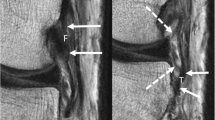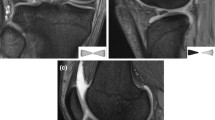Abstract
Purpose
To determine the usefulness of magnetic resonance (MR) imaging to distinguish stable from unstable tears of the anterior cruciate ligament (ACL) of the knee.
Materials and methods
MR images of 97 patients with surgically confirmed ACL tear were retrospectively reviewed. According to arthroscopic and clinical examination, these patients had 36 stable and 61 unstable (9 partial and 52 complete) ACL tears. MR images were interpreted by two blinded reviewers and scored with respect to previously reported primary and secondary MR signs of ACL injury. Based on a comprehensive assessment of all the MR findings, ACLs were categorized as being stable or unstable. MR accuracy was calculated considering only primary MR signs and considering both primary and secondary MR signs of ACL injury, separately. Accuracy of each individual primary and secondary MR sign was calculated.
Results
Considering only primary MR signs, sensitivity, specificity, and accuracy of MR were 77, 92, and 82%, respectively. Considering both primary and secondary MR signs, sensitivity, specificity, and accuracy of MR were 59, 81, and 67%, respectively. Of all MR signs, discontinuity and abnormal orientation had highest test accuracy (79 and 87%, respectively). Anterior tibial translation, uncovering of the posterior horn of the lateral meniscus, and hyperbuckled PCL were only seen in unstable ACLs (specificity 100%), but these secondary findings had low sensitivity (23%). Bone contusion around the lateral knee compartment was seen in both unstable and stable ACLs (accuracy 64%).
Conclusion
Previously reported MR imaging signs do not allow accurate distinction between clinically stable and unstable ACL injuries. Anterior tibial translation, uncovering of the posterior horn of the lateral meniscus, and hyperbuckled PCL, if present, are helpful signs in the diagnosis of an unstable tear. The presence of bone marrow edema around the lateral knee compartment is not predictive of ACL insufficiency.




Similar content being viewed by others
References
Lee JK, Yao L, Phelps CT, Wirth CR, Czajka J, Lozman J. Anterior cruciate ligament tears: MR imaging compared with arthroscopy and clinical tests. Radiology. 1988;166:861–4.
Mink JH, Levy T, Crues JV III. Tears of the anterior cruciate ligament and menisci of the knee: MR imaging evaluation. Radiology. 1988;167:769–74.
Umans H, Wimpfheimer O, Haramati N, Applbaum YH, Adler M, Bosco J. Diagnosis of partial tears of the anterior cruciate ligament of the knee: value of MR imaging. AJR Am J Roentgenol. 1995;165:893–7.
Yao L, Gentili A, Petrus L, Lee JK. Partial ACL rupture: an MR diagnosis? Skeletal Radiol. 1995;24:247–51.
Lawrance JA, Ostlere SJ, Dodd CA. MR diagnosis of partial tears of the anterior cruciate ligament. Injury. 1996;27:153–15.
Roychowdhury S, Fitzgerald SW, Sonin AH, Peduto AJ, Miller FH, Hoff FL. Using MR imaging to diagnose partial tears of the anterior cruciate ligament: value of axial images. AJR Am J Roentgenol. 1997;168:1487–91.
Colombet P, Dejour D, Panisset J-C, Siebold R, the French Arthroscopy Society. Current concept of partial anterior cruciate ligament ruptures. Orthop Traumatol Surg Res. 2010;96S:S109–18.
DeFranco MJ, Bach BR Jr. A comprehensive review of partial anterior cruciate ligament tears. J Bone Joint Surg Am. 2009;91:198–208.
Noyes FR, Mooar LA, Moorman CT III, McGinniss GH. Partial tears of the anterior cruciate ligament. Progression to complete ligament deficiency. J Bone Joint Surg Br. 1989;71:825–33.
McNally EG. Knee: ligaments. In: Vanhoenacker FM, Maas M, Gielen JL, editors. Imaging of orthopedic sports injuries. Berlin, Heidelberg, New York: Springer; 2007. p. 284–92.
Chan WP, Peterfy C, Fritz RC, Genant HK. MR diagnosis of complete tears of the anterior cruciate ligament of the knee: importance of anterior subluxation of the tibia. AJR Am J Roentgenol. 1994;162:355–60.
Tung GA, Davis LM, Wiggins ME, Fadale PD. Tears of the anterior cruciate ligament: primary and secondary signs at MR imaging. Radiology. 1993;188:661–7.
Remer EM, Fitzgerald SW, Friedman H, Rogers LF, Hendrix RW, Schafer MF. Anterior cruciate ligament injury: MR imaging diagnosis and patterns of injury. Radiographics. 1992;12:901–15.
Brandser EA, Riley MA, Berbaum KS, El-Khoury GY, Bennett DL. MR imaging of anterior cruciate ligament injury: independent value of primary and secondary signs. AJR Am J Roentgenol. 1996;167:121–6.
American Medical Association Subcommittee on Classification of Sports Injuries and Committee on the Medical Aspects of Sports. Standard nomenclature of athletic injuries. Chicago: American Medical Asociation; 1968. p. 99–100.
Petersen W, Zantop T. Partial rupture of the anterior cruciate ligament. Arthroscopy. 2006;11:1143–5.
Tsai KJ, Chiang H, Jiang CC. Magnetic resonance imaging of anterior cruciate ligament rupture. BMC Musculoskelet Disord. 2004;5:21.
Turner DA, Prodromos CC, Petasnick JP, Clark JW. Acute injury of the ligaments of the knee: magnetic resonance evaluation. Radiology. 1985;154:717–22.
Gallimore GW, Harms SE. Knee injuries: high-resolution MR imaging. Radiology. 1986;160:457–61.
Reicher RA, Hartzman S, Bassett LW, Mandelbaum B, Duckwiler G, Gold RH. MR imaging of the knee. I. Traumatic disorders. Radiology. 1987;162:547–51.
Leach WJ, King JB. Posterior reattachment of the torn anterior cruciate ligament. J Bone Joint Surg Br. 1994;76:159–60.
Snearly WN, Kaplan PA, Dussault RG. Lateral-compartment bone contusions in adolescents with intact anterior cruciate ligaments. Radiology. 1996;198:205–8.
Lintner DM, Kamaric E, Moseley JB, Noble PC. Partial tears of the anterior cruciate ligament. Are they clinically detectable? Am J Sports Med. 1995;23:111–8.
Conflict of interest
The authors declare that they have no conflict of interest.
Author information
Authors and Affiliations
Corresponding author
Rights and permissions
About this article
Cite this article
Van Dyck, P., Gielen, J.L., Vanhoenacker, F.M. et al. Stable or unstable tear of the anterior cruciate ligament of the knee: an MR diagnosis?. Skeletal Radiol 41, 273–280 (2012). https://doi.org/10.1007/s00256-011-1169-4
Received:
Revised:
Accepted:
Published:
Issue Date:
DOI: https://doi.org/10.1007/s00256-011-1169-4




